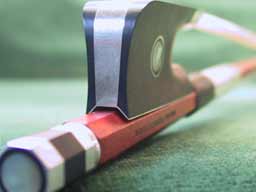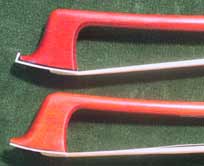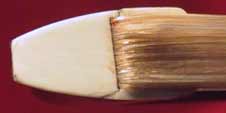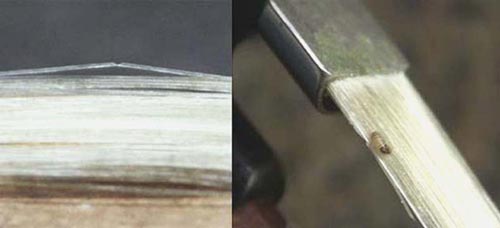It is very important to keep the thumb leather near the frog of a bow in good condition.  Worn on stick in thumb position
Worn on stick in thumb position  Worn on stick shown after frog removal
Worn on stick shown after frog removal
If it is worn through to the wood, have it replaced immediately. Many valuable bows have been severely damaged in this area by the thumbnail because the thumb leather was worn down and not replaced.

Loose eyelet resulting in frog warbling on stick
|
If the frog is loose or wiggles, the eyelet, which provides the female thread for the screw, may not be in the correct position, or the hole for the screw may have become too large. This should be checked by a professional.
The faceplate (tip) of the bow is not just an ornament; it protects the wood from damage. If the very tip of the faceplate breaks off, the exposed wood will wear, devaluing the bow. If a crack forms from the side of the mortise, the tip may not withstand the pressure of the plug. This should be attended to.
Wipe off the stick of the bow before storing it. Always store the bow in your case to avoid damage. Leaving a bow on the lip of a music stand is especially dangerous in orchestra situations.
Use the bow for playing only. Do not point or gesticulate with it while talking, and never applaud by tapping the bow against a music stand. (People do this, so we have to include it!)
Rosin the bow as needed for the desired consistency of sound. If a lot of white dust can be

The beak is missing on the tip of the lower bow |
seen on the instrument after playing, you are probably using too much rosin. When putting rosin on a bow, cover the ferrule (the metal ring where the hair enters the frog) with your thumb so the rosin will not hit the metal, which can chip or break the rosin.
If a single hair breaks, use scissors to cut it from the bow.? Pulling the hair will loosen the knots that hold the hair in the tip and frog.
Avoid touching the hair. The natural oils on your skin will counteract the gripping effect of the rosin.
Make sure you do not over-tighten the bow hair. The distance between the stick and the hair in the middle of the bow should not be much wider than a pencil for violin and slightly wider for a cello, and there should still be plenty of camber (curve) in the stick. Always loosen the tension of the bow after each playing session, for the bow can lose some of its camber if you do not.
Low Humidity

A cracked tip should be repaired as soon as possible |
Constant usage over time and high humidity can lengthen the hair, sometimes so much that it cannot be fully tightened. Conversely, if you travel to a dry area with a freshly rehaired bow, the hair may become so short that it cannot be loosened (because bowhair shrinks in dry weather). This constant tension can affect the camber (curve) of your bow. Additionally, during a sudden dry spell, the resulting shrinkage can break the head off of a bow that has not been loosened after playing. If you notice that your bow has been affected by either humid or dry conditions, take the bow to a violinmaker for correction.
The Bow Bug or Carpet Beetle

Bite hair (left) and Adult carpet beetle (right) |
If your bow has been stored in a closed case for a long period of time, you may notice that many of the bow hairs look as if they've been cut. This is due to the carpet beetle larva, which feeds on bow hair, tortoise shell and whalebone.
If you know you won't be using your bow for a period of time, don't leave it in a closed case for carpet beetle larvae thrive in dry, dark places. You may find it helpful to expose the inside of your case to sunlight for brief periods of time to discourage the larvae. For longer periods of storage, we recommend placing mothballs, cedar chips or camphor in your case and storing your bow in a sealed plastic bag (available from most dealers). |
Rehairing
At times you may feel that your bow hair fails to grab the strings enough. Heat, humidity, and oils from our skin mix with the rosin and cause bowhair to become dirty and gummy. If the hair is still full and evenly distributed, you can prolong its use simply by getting it cleaned by a violinmaker or other professional.
If too much hair is missing (usually on the playing side), the bow needs to be rehaired before the uneven pull of the hair warps the bow. Take the bow to a violinmaker for rehairing.
After a bow has been freshly rehaired, you may notice that the bow seems to have lost some of its sound quality (more noise, sandy sound, rougher feel, etc.). There is no need to return the bow for different hair. Instead, play the bow a lot for a week or two.Chances are the problem will disappear, and this is why: hair without rosin makes almost no sound at all if the strings are also clean. It is the rosin that makes the hair grip the strings enough to create a sound. The hair has an uneven, scaled surface that holds the rosin in place and until the rosin is worked in, the bow can sound sandy, etc.
Of course the quality of bow hair does vary. For example, some hair can have weak areas across the length which cause it to break sooner, and wavy hair is not the same length as straight hair, which makes it difficult to tighten all the hair.

